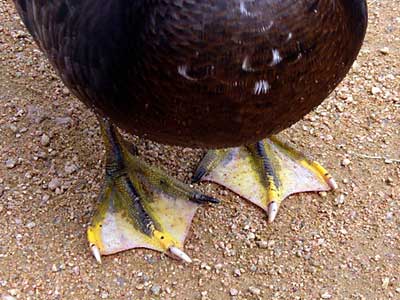Introduction
Water birds use their feet to swim through the water, often as a way to get food. Penguins need to dive and swim quickly through the water to chase and catch small fish as prey. Ducks swim to eat from the bottom of ponds, lakes, and streams. Each type of swimming bird has a unique adaptation for locomotion through the water.
How do ducks swim? According to the National History Museum: "Birds with webbed feet can paddle through the water and walk on mud. As a duck pushes its feet back, the web spreads out to provide more surface to thrust the water. Then, as the duck draws its foot forward and brings the toes together, the web folds up so there is less resistance to the water" (NHM, 2006). This resistance is in the form of friction, and is an important force in hydrodynamics and locomotion.

Here is a picture of two duck feet showing the webbing between the toes.
There are many different kinds of water birds, each with adaptations for swimming through the water. Ducks, geese, and pelicans have webbing between their toes. Other water birds, like grebes have flattened, lobed toes that help with diving and swimming. In this experiment you will use swim fins to make three sets of bird feet: one from a non-swimmer, one from a grebe, and one from a duck. Which adaptations will help a swimmer swim the fastest?
Terms and Concepts
To do this type of experiment you should know what the following terms mean. Have an adult help you search the internet, or take you to your local library to find out more!
- water birds
- ducks
- geese
- grebes
- penguins
- and many more...
- foot morphology
- surface area
- hydrodynamics
- locomotion
- friction
No comments:
Post a Comment